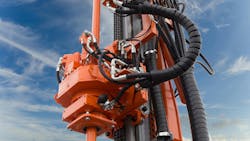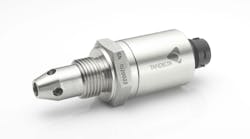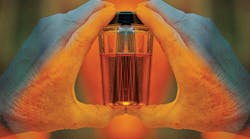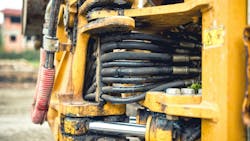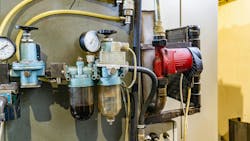Proper Hydraulic Fluid Selection Ensures Equipment Longevity and Performance
What you'll learn:
- Important factors to consider when choosing a hydraulic fluid.
- How hydraulic fluid choice can impact machine performance.
- Ways hydraulic oil are evolving to meet changing machine and application requirements.
Hydraulic systems power the machines that move industries, from construction sites to manufacturing plants. Yet, the importance of selecting the right hydraulic fluid is often underestimated.
Choosing the wrong fluid can erode performance, reduce equipment lifespan, and quietly chip away at a business’s bottom line. Getting it right isn’t just about matching specs, it’s about understanding your hydraulic system’s demands and making informed, forward-thinking choices.
Operating Conditions a Top Consideration for Hydraulic Fluid Selection
At the core of any hydraulic fluid decision is a simple but essential question: How well will this fluid perform under the specific operating conditions of my system?
The first and most critical step is to follow the hydraulic pump and equipment manufacturers’ specifications and recommendations. These guidelines ensure compatibility, optimal performance, and protection of system components.
Among the parameters specified, viscosity is one of the most crucial. It must align with your application's operating temperature range; if the viscosity is too low for the temperature, the fluid becomes too thin, creating a weaker lubricating film that cannot adequately protect metal surfaces, which leads to increased wear. If viscosity is it too high, the fluid becomes overly thick, making it harder to pump, causing the system to work harder which reduces efficiency and responsiveness.
In addition, pairing the correct viscosity with strong oxidation stability — a fluid’s ability to resist breakdown under heat and pressure — provides a solid foundation for reliable and long-lasting hydraulic system performance.
Another important factor to consider, but one that is often overlooked, is fluid cleanliness. Fluid cleanliness is measured by cleanliness codes established by the International Organization for Standardization (ISO) which reflect the number of particles in an oil.
The cleanliness of an oil has a direct impact on hydraulic system, and thus overall machine, performance. Up to 80% of wear in hydraulic systems is directly attributable to contamination. These aren’t abstract numbers. This is real, physical damage caused by microscopic particles circulating through a system again and again, degrading sensitive components over time.
Cleanliness standards vary by equipment type. A mobile system may tolerate the presence of more particles in its hydraulic fluid and thus allow use of oil meeting one code, while high-precision in-plant equipment may require use of an oil following a stricter cleanliness code. The key is to consult the owner's manual, which should spell out the proper cleanliness rating. Skipping this step can shorten the life of your components and spike your maintenance costs.
Read the below content to learn more about technologies and techniques for ensuring hydraulic fluid cleanliness.
Common Missteps and Misconceptions During the Hydraulic Fluid Selection Process
Too often, end users make avoidable mistakes in their hydraulic fluid selection. One of the most common is over-consolidation.
Companies want to minimize inventory and simplify operations. They attempt to do so by using the same fluid across a mixed fleet. But this can backfire if the chosen hydraulic fluid doesn’t meet the needs of every system.
Just because two fluids fall under the “hydraulic” label doesn’t mean they’re interchangeable. Differences in viscosity, additives, and compatibility can lead to accelerated wear, inefficient operation, or even system failure.
Another myth is that all fluids protect equally, and that cheaper fluids are sufficient and less expensive in the long run. But a low-cost fluid lacking proper anti-wear or oxidation resistance can ultimately cost more in downtime, repairs, and lost productivity. The cheapest gallon at purchase isn’t always the most cost-effective over the long term.
Environmental and Regulatory Pressures Driving Hydraulic Fluid Choices
Environmental awareness is no longer an afterthought; it is a priority. Whether working around waterways, in environmentally sensitive areas, or simply striving to reduce environmental impact, the choice of fluid can have major implications beyond system performance.
Environmental fluids that were once considered niche or lower performing have improved dramatically in recent years. Modern biodegradable and low-toxicity formulations often rival or surpass traditional fluids in both performance and longevity. In fact, some operators are choosing to use environmentally acceptable lubricants (EAL) across their entire fleet and not just when required, because the cost of contamination is too high to risk.
There’s also a growing global trend toward stronger environmental regulation. While some regions still lag behind, others are quickly moving ahead, meaning that proactive decisions today can prevent regulatory headaches tomorrow.
Watch our video interview below with Rebecca Zwetzig, Sector Manager for Chevron Industrial Lubricants, to learn more about the advancements being made in biodegradable hydraulic fluids.
Real-World Results: When the Right Fluid Pays Off
Field testing and customer experiences consistently support the value of selecting the right hydraulic fluid. In one case, standardized testing compared a commonly used ISO 68 fluid with an OEM-recommended ISO 46 option. Despite assumptions that the higher viscosity ISO 68 oil was better for warmer climates, it resulted in a 10% drop in fuel economy and a 10% loss in productivity. Simply returning to the OEM spec'd version delivered measurable gains.
In another example, a customer operating near water sources upgraded to a synthetic environmentally friendly hydraulic oil product from conventional hydraulic oil to meet environmental requirements. The improved fluid not only delivered on compliance, but also extended drain intervals significantly, so much so that it paid for itself through reduced maintenance alone.
Hydraulic System Innovations Prompting New Fluid Formulations to Consider
Hydraulic fluid technology isn’t standing still. As OEMs push for higher system pressures and tighter tolerances, the demands on fluids continue to evolve.
However, this evolution in hydraulic systems and fluids has made varnish (the buildup of insoluable contaminants) a growing concern. This was once a problem primarily in industrial environments, but it is now increasingly an issue in mobile equipment as well.
As hydraulic systems become more compact and operate under higher pressures, localized heat can degrade even stable fluids, resulting in sticky deposits that impair valves and controls. Additive technology focused on varnish mitigation is becoming a major area of advancement, and one that forward looking maintenance teams should keep on their radar.
Cost vs. System Performance: What is Most Important in the Long Run
Perhaps the most important takeaway for selecting the right hydraulic fluid is this: Start with the equipment, not the price tag. Determine what the system needs to run at its highest level, then find the fluid that meets or exceeds that standard.
Cost considerations matter, of course, but they come later. Begin by asking, “What demands does my system place on the fluid?” not “What’s the cheapest option?”
Every hydraulic system is different, and every decision has downstream consequences. However, with a little knowledge and a thoughtful approach, selecting the right hydraulic fluid can significantly extend equipment life, enhance efficiency, and deliver measurable value far beyond the initial purchase.
This article was written and contributed by Max Cundiff, Industrial Sector Manager, Chevron.
About the Author
Max Cundiff
Industrial Sector Manager, Chevron
Max Cundiff is the Industrial Sector Manager at Chevron, where he brings more than a decade of experience within the oil and gas industry. With a background spanning customer relationship management, international business, and strategic growth initiatives, he is dedicated to helping customers improve performance while advancing Chevron’s industrial market presence. Max holds both a BS in Business Administration and an MBA with an emphasis in Entrepreneurship from the University of Louisville.

Leaders relevant to this article:
